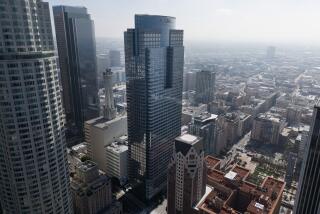Del Mar Ignores Poll, Seeks Grant to Keep Smokestack as Coastal Landmark
Is the stack doomed?
Yes, the days may be numbered for the venerable powerhouse smokestack, a huge concrete edifice that has towered over upscale Del Mar for more than 60 years.
Public opinion seems to favor the structure’s demise. A recent poll, mailed by the city to 4,200 registered voters, showed that four out of five respondents did not want the stack retained as a Del Mar landmark.
Of the surveys returned to the city, 379 people favored demolishing the smokestack, and 86 wanted to see it remain. The closest the stack got to a favorable response was a question about using state money to save the structure, with 78 respondents supporting the grant and 80 opposed.
City Perseveres in Effort to Win Grant
Undeterred by the poll results, city officials are going forward with an effort to win a $200,000 state historical grant in hopes of preserving the smokestack, which was built near the beach in the mid-1920s to help supply electricity to the old Del Mar Hotel and other parts of town.
But officials are not optimistic. Mayor John Gillies said “chances are slim” that the city will get the grant, making it almost inevitable that the stack “will be demolished.”
“I was disappointed by the poll,” Gillies said. “Personally, I’d like to save it. It’s just such a technological anomaly, it seems worth saving.”
Although the smokestack appears destined for the wrecker’s ball, the adjacent two-story powerhouse building, which served as a boiler room, is scheduled for preservation. City officials want to turn the building into a community center and have applied for another state grant to cover the expected $300,000 in rehabilitation costs.
The 60-foot-high smokestack, for years the only high-rise in Del Mar, helped provide electricity for just more than a decade. It was taken out of service in 1936, when San Diego Gas & Electric Co. began providing power to Del Mar.
Remains a Coastal Landmark
Nonetheless, the structure remained a coastal landmark. During the 1950s, the powerhouse building became a club featuring jazz bands, and the smokestack was used as a vertical signpost to advertise the spot, known as “The Roaring ‘20s.”
A research firm that was designing reverse osmosis techniques to turn seawater into drinking water occupied the building in the 1960s. In 1977, an investor bought the property and planned to convert the powerhouse into a swank restaurant, but the city balked at the idea and eventually bought the property.
Today, the stack is flanked by a grassy park and a restaurant. The final phase of the park project involves restoration of the powerhouse building and, perhaps, the smokestack.
Even if the city gets the money, rehabilitation of the stack will not be easy. The structure’s concrete skin has been stripped in spots, exposing the steel frame to the salty sea air.
Officials estimate it would cost at least $200,000 to restore the stack and have toyed with the idea of erecting a replica for about $150,000. The cost of demolishing the smokestack is estimated at $30,000 to $65,000.
“I think the bottom line will be whether we can get funding from outside the city,” said Councilwoman Brooke Eisenberg. “I personally love it. I just think it says ‘powerhouse’ to me. I mean, what’s a powerhouse without a smokestack?”
More to Read
Sign up for Essential California
The most important California stories and recommendations in your inbox every morning.
You may occasionally receive promotional content from the Los Angeles Times.










![[20060326 (LA/A20) -- STATING THE CASE: Marchers organized by unions, religious organizations and immigrants rights groups carry signs and chant in downtown L.A. "People are really upset that all the work they do, everything that they give to this nation, is ignored," said Angelica Salas of the Coalition of Humane Immigrant Rights. -- PHOTOGRAPHER: Photographs by Gina Ferazzi The Los Angeles Times] *** [Ferazzi, Gina -- - 109170.ME.0325.rights.12.GMF- Gina Ferazzi/Los Angeles Times - Thousands of protesters march to city hall in downtown Los Angeles Saturday, March 25, 2006. They are protesting against House-passed HR 4437, an anti-immigration bill that opponents say will criminalize millions of immigrant families and anyone who comes into contact with them.]](https://ca-times.brightspotcdn.com/dims4/default/34f403d/2147483647/strip/true/crop/1983x1322+109+0/resize/840x560!/quality/75/?url=https%3A%2F%2Fcalifornia-times-brightspot.s3.amazonaws.com%2Fzbk%2Fdamlat_images%2FLA%2FLA_PHOTO_ARCHIVE%2FSDOCS%2854%29%2Fkx3lslnc.JPG)